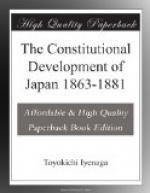All the more important towns in the country were thus made able to communicate with one another as early as 1880.
In 1879 Japan joined the International Telegraph Convention, and since then she can communicate easily with the great powers of the world through the great submarine cable system. “Compared with the state of ten years ago, when the ignorant people cut down the telegraph poles and severed the wires,” exclaims Count Okuma, “we seem rather to have made a century’s advance.”
2. Postal System. “Previous to the Restoration,” to quote further from Count Okuma, “with the exception of the posts sent by the Daimios from their residences at the capital to their territories, there was no regularly established post for the general public and private convenience. Letters had to be sent by any opportunity that occurred, and a single letter cost over 25 sen for a distance of 150 ri. But since the Restoration the government for the first time established a general postal service, and in 1879 the length of postal lines was 15,700 ri (nearly 40,000 English miles), and a letter can at any time be sent for two sen to any part of the country. In 1874 we entered the International Postal Convention, and have thus obtained great facilities for communicating with foreign countries."[2]
3. Railroad. The first railway Japan ever saw was the model railway constructed by Commodore Perry to excite the curiosity of the people. But it was not until 1870 that the railroad was really introduced into Japan. The first rail was laid on the road between Tokio and Yokohama. This road was opened in 1872. It is 18 miles long. The second line was constructed in 1876, and runs between Hiogo and Kioto via Osako. And the year 1880 saw the opening of the railroad between Kioto and Otsu. This line between Hiogo and Otsu is 58 miles long. So at the end of the period which we are surveying Japan had a railway system of 31 ri and 5 cho (about 78 English miles).
This was nothing but a child-play compared with the railroad activity which the later years brought forth, for now we have a railway system extending over one thousand two hundred miles. But this concerns the later period, so we shall not dwell upon it at present.
4. Steamers and the coasting trade. In 1871 the number of ships of foreign build was only 74, but by 1878 they had reached 377. The number of vessels of native build in 1876 was 450,000, and in 1878 had reached 460,000.[3]
“Since the Restoration the use of steamers has daily increased, and the inland sea, the lakes and large rivers are now constantly navigated by small steamers employed in the carrying trade.”
With the increased facility of communication, commerce and trade were stimulated. In 1869 the total amount of imports and exports was 33,680,000 yen, and in 1879 64,120,000 yen. Imports had grown from 20,780,000 yen to 36,290,000 yen, and exports from 12,909,000 yen to 27,830,000 yen; in the one case showing an advance from 2 to 3-1/2, in the other from 2 to 5.[4]




